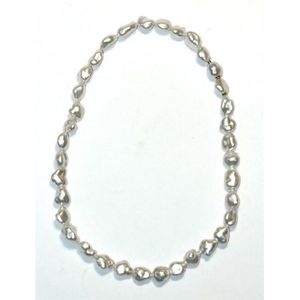Paspaley Keshi Pearl Necklace with Diamond Swap Clasp
You must be a subscriber, and be logged in to view price and dealer details.
Subscribe Now to view actual auction price for this item
When you subscribe, you have the option of setting the currency in which to display prices to $Au, $US, $NZ or Stg.
- Keshi Pearls - Keshi is a Japanese word meaning 'poppy seed', but not an indicator of the true size of the pearl. But keshi pearls are small, and are usually irregular in shape. They are sold by weight rather than size as is usual with pearls. Originally a by-product of pearl farming, most Keshi pearls are now deliberately cultivated.
- Brilliant Cut - In their naturally occuring state diamonds have little life or sparkle and for many centuries were simply cut in half and worn in amulets. Invented at the end of the 17th century by a Venetian diamond cutter, a "brilliant cut" diamond has 58 facets arranged in a regular geometric relationship, with 33 above the crown and 25 below on the pavilion.
The introduction of the brilliant cut increased the popularity of diamonds in jewellery as it was the first cut to reveal the fire of the diamond, with the light being internally reflected from one facet to another, and was superior to the previously used table cut and rose cut.Variants to the brilliant cut have emerged since the end of the 17th century, but the popularity of the original brilliant cut has continued to the present time, where it is still the most commonly found cut.
.
This item has been included into following indexes:
- necklaces, diamond - diamond and pearl 448
- necklaces, gold - gold with diamonds 2,054
-
necklaces, pearl
- pearl, Baroque 323
- pearl, Keshi 43
- Paspaley pearls (Australia) - necklaces, designers 109
Visually similar items

A strand of South Sea pearls, featuring thirty three round pearls of pinky white hues, measuring 12.0 mm to 14.0 mm, to a ball clasp, in 18ct gold, total length 475 mm.

A strand of South Sea pearls, comprising thirty one graduated near round pearls of silver and pink hues measuring 11.0 mm to 14.9 mm, to an 18ct white gold ball clasp, total length 430 mm. Condition: Presents in very good condition, pearls are well matched

A strand of Baroque South Sea pearls, the graduated pearls of cream and white hue measuring 11.10 mm to 14.30 mm, to a ball clasp with brush finish in 18ct gold, total length 480 mm. Condition: pearls display fine lustre and are well matched. Some growth l

A strand of South Sea pearls, the graduated round pearls of creamy pink hues measuring 12.60 mm - 15.60 mm, to a spherical diamond set magnetic clasp, total length 430 mm
